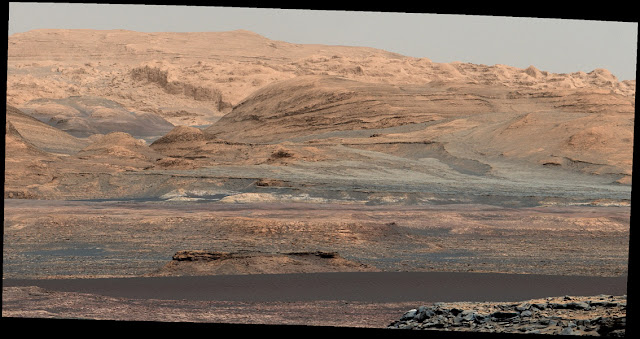Image Source: NASA via The Planetary Society.
NASA's Curiosity rover is now crossing the Bagnold Dunes on the northwestern edge of Mount Sharp (Aeolis Mons), an 18,000 foot high mountain (a bit smaller than Mount Kilimanjaro, about the same size as Mount McKinley). Wiki on Curiosity's current status:
The mountain sits at the centre of the planet's Gale Crater and is named for geomorphologist Robert P. Sharp (1911-2004), an expert on the geological surfaces of Earth and Mars. Mount Sharp "is the 15000th named feature" in the Gazetteer of Planetary Nomenclature, a list of all topographical features named in the solar system with the approval of the International Astronomical Union. Yes, the mountain's dune belt made me think of this opening film sequence.As of November 30, 2015, Curiosity has been on the planet Mars for 1179 sols (1211 days) since landing on August 6, 2012.
NASA/JPL: "The dark band in the lower portion of this Martian scene is part of the 'Bagnold Dunes' dune field lining the northwestern edge of Mount Sharp, inside Gale Crater. The view combines multiple images taken with the Mast Camera (Mastcam) on NASA's Curiosity Mars rover on Sept. 25, 2015, during the 1,115th Martian day, or sol, of Curiosity's work on Mars. ... The view is toward south-southeast. Curiosity will visit examples of the Bagnold Dunes on the rover's route to higher layers of Mount Sharp. The informal name for the dune field is a tribute to British military engineer Ralph Bagnold (1896-1990), a pioneer in the study of how winds move sand particles of dunes on Earth." Images Source: NASA/JPL.
Mount Sharp, seen in the distance here by the rover on 6 August 2012 is Curiosity's main research focus: "This image taken by NASA's Curiosity shows what lies ahead for the rover -- its main science target, Mount Sharp. The rover's shadow can be seen in the foreground, and the dark bands beyond are dunes. Rising up in the distance is the highest peak Mount Sharp at a height of about 3.4 miles, taller than Mt. Whitney in California. The Curiosity team hopes to drive the rover to the mountain to investigate its lower layers, which scientists think hold clues to past environmental change. This image was captured by the rover's front left Hazard-Avoidance camera at full resolution shortly after it landed." Image Source: NASA via Wiki.
The traverse maps above show Curiosity's journey thus far, with the Bagnold Dunes and Mount Sharp on the right side of the maps. The rover started from Bradbury Landing on 6 August 2012 and moved to nearby Yellowknife Bay and Glenelg in 2012-2013; it has now arrived at the edge of the mountain via the dune belt. Every stop along the rover's route of a few short kilometres has been given a name. Images Sources: NASA and Wiki.
The traverse maps above show Curiosity's journey thus far, with the Bagnold Dunes and Mount Sharp on the right side of the maps. The rover started from Bradbury Landing on 6 August 2012 and moved to nearby Yellowknife Bay and Glenelg in 2012-2013; it has now arrived at the edge of the mountain via the dune belt. Every stop along the rover's route of a few short kilometres has been given a name. Images Sources: NASA and Wiki.
Curiosity rover at the base of Mount Sharp as viewed from space (14 September 2015/Sol 1104; click to enlarge to see the faint lines of the rover's route). Image Source: Wiki via Mars Reconnaissance Orbiter/HiRISE camera.
NASA decided to land Curiosity at Gale Crater because of Mount Sharp's interesting topography at the crater's centre. Image Source: NASA.


























No comments:
Post a Comment